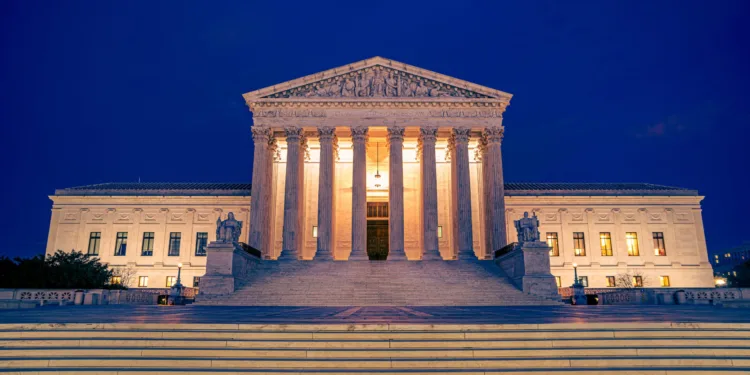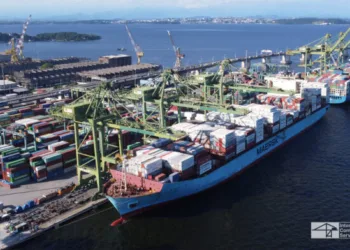With two requests before the Supreme Court to have the nine justices take up the issue of broker liability, the Transportation Intermediaries Association has weighed in on one of them, saying that small brokers are increasingly faced with an “acute existential threat” if there is not clarification of conflicting court rulings.
The TIA’s brief, submitted by the transportation practice of the Benesch Law Firm on behalf of the TIA, was specifically filed in the case of Total Quality Logistics, as the petitioner to the court, vs. Robert Cox. The two had squared off in the case of Cox vs. TQL in the Sixth Circuit, litigation that ultimately went against TQL over the question of whether a broker can be held liable for a negative outcome (it doesn’t necessarily need to be an accident with a fatality or injury) involving a truck it hired to meet a shipper’s request.
TQL, generally considered the second largest brokerage, lost that case, and has asked the Supreme Court for certiorari as it appeals the appellate court ruling.
But TQL vs. Cox is not the only case before the Supreme Court asking for a review of broker liability.
There is also a request for review In the case of Montgomery vs. Caribe Transport II, a decision in the Seventh Circuit that earlier this year found in favor of C.H. Robinson’s (NASDAQ: CHRW) defense it was protected by the Federal Aviation Administration Authorization Act (FAAAA) of 1994 from being held liable for a 2017 crash involving a Caribe truck that injured Shawn Montgomery.
Two FAAAA cases at once are in front of the justices
The Supreme Court has rejected earlier certiorari requests for the court to take up conflicting court decisions over broker liability under the FAAAA. But the key argument made in the past in favor of the court taking up the issue–that circuit court decisions are at odds–is now particularly stark given that there are two concurrent requests for certiorari before it, one in which the brokerage company lost at the circuit level and another in which a brokerage was victorious.
The issue the TIA and others want the court to take up boils down to one phrase: “with respect to motor vehicles.”
It’s part of the “safety exception” of FAAAA, which as TIA says in its brief to the Court means that “states retain regulatory authority over motor vehicles, despite the otherwise broad preemptions language in the statute.”
The safety exemption “allows states to continue to regulate the safety of motor carriers, trucks and cars operating in the state,” according to the TIA brief.
Where the divide comes in is that two circuits have interpreted the safety clause’s grant of state regulatory powers “with respect to motor vehicles” to include brokers.
Earlier certiorari requests denied
One of those cases is Miller vs. C.H. Robinson, which the Court decided in 2022 not to review. That is a case where a circuit–the Ninth–ruled the safety exception did not protect a brokerage from legal action from all incidents related to a truck it hired.
The Court also rejected a chance to take up the issue when it denied certiorari in the case of Ye vs. GlobalTranz, where a circuit court finding that “with respect to a motor vehicle” did not include brokers was upheld.
“The resulting landscape leaves brokers and shippers subject to a dizzying array of conflicting standards across the country and no chance of consensus is on the horizon,” the TIA’s attorneys wrote. “The lower courts are irreconcilably at odds.”
While the issue is not new, having knocked on the Supreme Court’s door already, the arguments made by the TIA and its attorneys were notable in how they predicted the inconsistency might affect the structure of the brokerage sector.
In particular, the brief lays out a scenario in which smaller brokers find themselves unable to keep up with legal uncertainty while it does business across the country in different circuits with operating under conflict precedents.
If the Supreme Court does not clarify the conflict among the circuits, it means that brokers “would be forced to traverse a complex maze of dozens of regulatory and general tort-liablity schemes, effectively nullifying any deregulatory goal Congress sought to achieve,” TIA says in its brief. “No ‘standard’ way of performing business would exist.”
The brief makes the argument that the federal government through the Federal Motor Carrier Safety Administration already performs the task of ensuring a carrier is safe enough to operate on the highways. It is redundant to ask a broker to do the same, according to the TIA.
“A small brokerage business employing a handful of employees lacks the resources to ‘outsmart’ the federal government’s decision to authorize a motor carrier to operate on the public road,” the brief says. “A small broker cannot collect, examine and reach empirically sound evaluative conclusions regarding whether a federally licensed motor carrier is safe to use.”
Such a scenario would result in brokers, big and small, choosing not to engage with smaller carriers they may not know, the TIA brief says. They would be “forced to do business with only the most established motor carriers, which would ‘effectively eliminate some motor carriers from the transportation market altogether.’”
(Ironically, that quote within a quote came from the Miller vs. C.H. Robinson Ninth Circuit decision, which went against the brokerage community).
Avoidance of new carriers “naturally stunts potential growth in a crucial economic sector,” the TIA brief says.
Barrier to entry
And on the brokerage side, the TIA argues, “the potential for catastrophic liability creates a complex and colossal barrier to entering the brokerage market.”
“Brokers must be able to factor this type of potential ‘nuclear’ liability exposure into their businesses (specifically, their rates and services) and their plans for the future,” the brief writes.
The use of the term “rates and services” was likely not chosen lightly. The FAAAA specifically prohibits state action that could impact a transportation company’s “prices, routes, or services,” before then tacking on the safety exemption. While not saying so explicitly, the argument against holding brokers to the safety exemption by ruling that they fall under the “with respect to motor carriers” clause of the FAAAA, holds the potential to impact “prices, routes or services.”
In an email to FreightWaves, Marc Blubaugh, head of the Benesch transportation practice that wrote the brief, said the Supreme Court conference to discuss whether it should take up Montgomery vs. Caribe had been scheduled for later this month, but was delayed to an undecided date.
He said there was no reason given for the delay. But Blubaugh added that it was possible that arrival of the TQL vs. Cox case, which came after the Montgomery case, could have led the justices to hold back discussing the Montgomery certiorari petition to instead discuss both cases dealing with broker liability and the FAAAA.
More articles by John Kingston
Werner faces social media storm over Kenyan driver rumors
Raucous Teamsters demonstration at Amazon in New York belies tough road for unionization efforts
First step taken by Trump administration to supplant Biden’s independent contractor rule at Labor department
The post TIA warns: TQL-linked broker liability case threatens industry appeared first on FreightWaves.






















